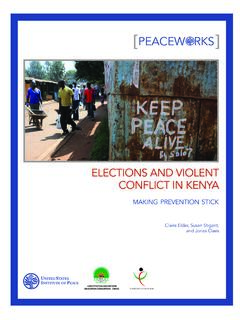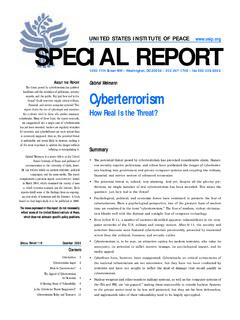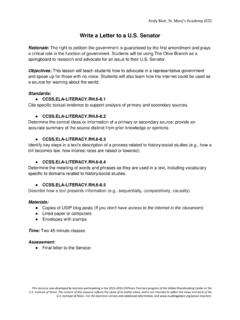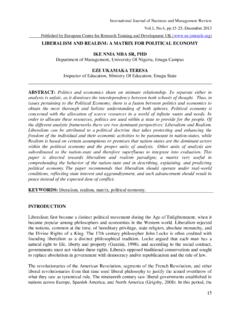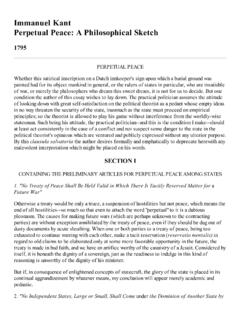Transcription of Conflict analysis - United States Institute of Peace
1 Purpose of chapterThis chapter explains:lwhat Conflict analysis is and why it matterslhow to undertake an analysisWho should read itThe chapter is aimed at practitioners in governments, civilsociety (local and international) and donor organisationsconcerned with development, humanitarian assistanceand peacebuilding. The chapter may also be of interest toothers (eg in the private sector, the diplomatic field, etc).Why they should read itBecause Conflict analysis is the foundation of conflictsensitivity and without a good understanding of thecontext in which interventions are situated, organisationsthat support or directly implement them mayunintentionally help to fuel violent Conflict or toexacerbate existing tensions.
2 Conflict analysis helpsorganisations towards a better understanding of thecontext in which they work, and a Conflict What is Conflict analysis and why is it important?2. Key elements of Conflict analysis3. Working with indicators4. Integrating Conflict analysis and other forms ofassessment5. Better practice in Conflict analysis6. Choosing the right tool for Conflict analysis7. EndnotesAnnex 1. Tools for Conflict is Conflict analysisand why is it important? Conflict analysis is the systematic study of the profile,causes, actors, and dynamics of Conflict (seeSection 2). Ithelps development, humanitarian and peacebuildingorganisations to gain a better understanding of the contextin which they work and their role in that analysis can be carried out at various levels (eglocal, regional, national, etc) and seeks to establish thelinkages between these levels (see Fig 1).
3 Identifying theappropriate focus for the Conflict analysis is crucial: theissues and dynamics at the national level may be differentfrom those at the grassroots. But while linking the level ofconflict analysis (eg community, district, region ornational) with the level of intervention (eg project, sector,policy), it is also important to establish systematic linkageswith other interrelated levels of Conflict dynamics. Theselinkages are important, as all of these different levelsimpact on each 2 Conflict analysisFor example, when operating at the project level, it isimportant to understand the context at the level at whichthe project is operating (eg local level), so the focus of theanalysis should be at that level; but the analysis shouldalso take account of the linkages with other levels (egregional and national).
4 And similarly when operating atthe regional, sector or national discussed inChapter 1, Conflict sensitivity is about:lunderstanding thecontextin which you operatelunderstanding theinteractionbetweenyourinterventionand the contextlactingupon the understanding of this interaction, inorder to avoidnegative impactsand analysis is thus a central component ofconflict-sensitive practice, as it provides the foundation toinform Conflict sensitive programming, in particular interms of an understanding of the interaction between theintervention and the context. This applies to all forms ofintervention development, humanitarian, peacebuilding and to all levels project, programme, and other words, Conflict analysis will help:lto define new interventions and to Conflict -sensitiseboth new and pre-defined interventions (eg selection ofareas of operation, beneficiaries, partners, staff, timeframe).
5 (Planning stage)lto monitor the interaction between the context and theintervention and inform project set-up and day-to-daydecision-making. (Implementation stage)lto measure the interaction of the interventions and theconflict dynamics in which they are situated.(Monitoring and evaluation stage) elements of conflictanalysisThis section synthesises the key elements of conflictanalysis as they emerge from the various Conflict analysistools documented inAnnex 1. Looking at each of theseelements will help to develop a comprehensive picture ofthe context in which you operate. Depending on yourspecific interest, however, you may want to emphasiseparticular aspects of key importance.
6 For example, if theemphasis is on the identification of project partners andbeneficiaries, a good understanding of Conflict actors andhow potential partners and beneficiaries relate to themwill be the primary requirement. (SeeBox 2in thischapter).Generally, good enough thinking is required. This meansaccepting that the analysis can never be exhaustive, norprovide absolute certainty. Conflict dynamics are simplytoo complex and volatile for any single Conflict analysisprocess to do them justice. Nevertheless, you should trustyour findings, even though some aspects may remainunclear. Do not be discouraged; some analysis , no matterhow imperfect, is better than no analysis at following diagram highlights the common keyfeatures of Conflict analysis , which will contribute tounderstanding the interaction between the context andfuture/current interventions (see Chapters3and4for theproject and sectoral (sector wide) levels respectively).
7 Thecommon features are the Conflict profile, actors, causesand dynamics. Each is further described approaches to development, humanitarian assistance and Peace building:tools for Peace and Conflict impact assessment |Chapter Conflict profile provides a brief characterisation of thecontext within which the intervention will be 1 Key questions for a Conflict profileWhat is the political, economic, and socio-cultural context?eg physical geography, population make-up, recent history,political and economic structure, social composition,environment, geo-strategic are emergent political, economic, ecological, andsocial issues?
8 Eg elections, reform processes, decentralisation, newinfrastructure, disruption of social networks, mistrust, returnof refugees and internally displaced persons (IDPs), militaryand civilian deaths, presence of armed forces, mined areas, specific Conflict prone/affected areas can be situatedwithin this context?eg, areas of influence of specific actors, frontlines around thelocation of natural resources, important infrastructure andlines of communication, pockets of socially marginalised orexcluded there a history of Conflict ?eg critical events, mediation efforts, external : this list is not exhaustive and the examples may differaccording to the of conflictIn order to understand a given context it is fundamental toidentify potential and existing Conflict causes, as well aspossible factors contributing to Peace .
9 Conflict causes canbe defined as those factors which contribute to people sgrievances; and can be further described as:lstructural causes pervasive factors that have becomebuilt into the policies, structures and fabric of a societyand may create the pre-conditions for violent conflictlproximate causes factors contributing to a climateconducive to violent Conflict or its further escalation,sometimes apparently symptomatic of a deeperproblemltriggers single key acts, events, or their anticipationthat will set off or escalate violent conflicts also tend to generatenew causes(egweapons circulation, war economy , culture of violence)
10 ,which help to prolong them the main causes and factors contributing to Conflict andto Peace are identified, it is important to acknowledge thatconflicts are multi -dimensional and multi-causalphenomena that there is no single cause of Conflict . It isalso essential to establish linkages and synergies betweencauses and factors, in order to identify potential areas forintervention and further prioritise them. Some of the toolsinAnnex 1 eg Clingendael / Fund for Peace , RTC offermethods to assess the relative importance of differentfactors. Many tools developed for Conflict analysis alsocategorise Conflict causes or issues by governance,economics, security and socio-cultural 2 Key questions for an analysis of Conflict causesWhat are structural causes of Conflict ?
